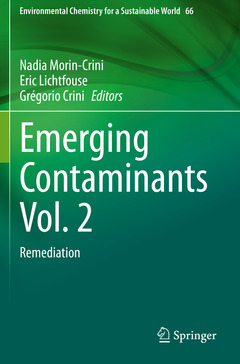Description
Emerging Contaminants Vol. 2, 1st ed. 2021
Remediation
Environmental Chemistry for a Sustainable World Series, Vol. 66
Coordinators: Morin-Crini Nadia, Lichtfouse Eric, Crini Grégorio
Language: English
Subjects for Emerging Contaminants Vol. 2:
Publication date: 04-2022
401 p. · 15.5x23.5 cm · Paperback
Publication date: 04-2021
Support: Print on demand
Description
/li>Contents
/li>Biography
/li>Comment
/li>
Preface
Chapter 1 Emerging Contaminants: Remediation
Nadia Morin-Crini, Eric Lichtfouse, Marc Fourmentin, Ana Rita Lado Ribeiro, Constantinos Noutsopoulos, Francesca Mapelli, Éva Fenyvesi, Melissa Gurgel Adeodato Vieira, Lorenzo A. Picos-Corrales, Juan Carlos Moreno-Piraján, Liliana Giraldo, Tamás Sohajda, Mohammad Mahmudul Huq, Jafar Soltan, Giangiacomo Torri, Monica Magureanu, Corina Bradu and Grégorio Crini
Chapter 2 Electrochemical Treatments for the Removal of Emerging Contaminants
Borislav N. Malinović, Jernej Markelj, Helena Prosen, Andreja Žgajnar Gotvajn and Irena Kralj Cigić
Chapter 3 Technologies to Remove Selenium From Water and Wastewater
Eric Lichtfouse, Nadia Morin-Crini, Corina Bradu, Youssef-Amine Boussouga, Mehran Aliaskari, Andrea Iris Schäfer, Soumya Das, Lee D. Wilson, Michihiko Ike, Daisuke Inoue, Masashi Kuroda, Sébastien Déon, Patrick Fievet and Grégorio Crini
Chapter 4 Advanced Treatments for the Removal of Alkylphenols and Alkylphenol Polyethoxylates from Wastewater
Grégorio Crini, Cesare Cosentino, Corina Bradu, Marc Fourmentin, Giangiacomo Torri, Olim Ruzimuradov, Idil Arslan Alaton, Maria Concetta Tomei, Ján Derco, Mondher Barhoumi, Helena Prosen, Borislav N. Malinović, Martin Vrabeľ, Mohammad Mahmudul Huq, Jafar Soltan, Eric Lichtfouse and Nadia Morin-Crini
Index
Dr. Eric Lichtfouse is a professor of environmental chemistry and scientific communication at Aix-Marseille University, France and Xi’an Jiaoting University, China. He has invented carbon-13 dating based on the discovery of temporal pools of organic molecules in soils. He is Chief Editor and co-founder of the journal Environmental Chemistry Letters, and the book series Sustainable Agriculture Reviews and Environmental Chemistry for a Sustainable World. He has published the book Scientific Writing for Impact Factor Journals.
Dr. Grégorio Crini is an environmental polymer scientist at the University of Bourgogne Franche-Comté, Besançon, France. His research activities focus on the design of new polymer networks and the environmental aspects of polysaccharide chemistry. He has published more than 210 papers in international journals and is a highly cited researcher with an h-index of 38 and more than 11,800 citations.Presents advanced techniques of remediation of polluted water, soil and air
Details contaminant-induced antibiotic resistance and diseases
Reviews the latest analytical tools to monitor pollutants




